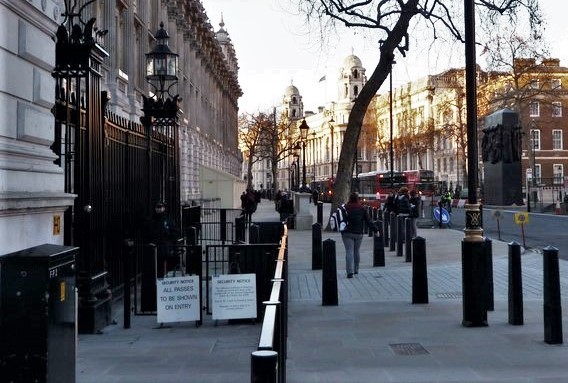ISO 22341:2021

|
| The junction between Whitehall and Downing Street incorporates security measures that allow only restricted access. |
Contents |
[edit] Introduction
The International Organisation for Standardisation (ISO) is an independent organisation responsible for the production of voluntary international standards. The main products developed by ISO are international standards that set out requirements, guidance, specifications and characteristics that ensure consistency of materials, products, services and processes.
[edit] BS ISO 22341:2021
ISO 2234:2020 Security and resilience — Protective security — Guidelines for crime prevention through environmental design was published in January 2021. The purpose of this standard is to provide guidelines to organisations for establishing the basic elements, strategies and processes for preventing and reducing crime (and the fear of crime) at a new or existing built environment.

|
It recommends the establishment of countermeasures and actions to treat crime and security risks in an effective and efficient manner by leveraging environmental design. For the purposes of the standard, environmental design refers to the applied arts and sciences dealing with creating the human-designed environment.
This standard is intended to promote a common understanding of crime prevention through environmental design (CPTED) and its proactive preventive measures implemented through environmental design and management. CPTED is an initiative that can be applied to the built environment to create safer neighbourhoods. It is also thought to promote and improve public health, quality of life and sustainability.
[edit] CPTED background
The origins of CPTED can be traced back to early human settlements. It became more prevalent in America around 1960, during a time of urban renewal and social change. More formalised CPTED concepts were adopted in the 1970s. The term CPTED was officially introduced in 1971 by the criminologist C. Ray Jeffery in his article, Crime Prevention Through Environmental Design.
CPTED concepts originated from criminology and crime opportunity theories and studies. Since its introduction, it has been included as part of many other crime prevention strategies in modern urban planning.
It has a theoretical foundation based on firm evidence of significant crime and fear reduction gained from a series of evaluations in the field of environmental psychology, criminology and crime science. For example, an examination of criminal behaviour demonstrated that choices made by the criminal were more influenced by risk (specifically, the risk of being seen and arrested) rather than access, reward or even punishment. Consistent with this research, CPTED based strategies emphasise enhancing the perceived risk of detection and apprehension.
[edit] Applying ISO 22341:2021
While there are many different sources of guidance in existence, ISO 22341:2021 is the first international standard to touch upon this area. It examines the application of CPTED practices for all kinds of sites, including residential areas, commercial areas, industrial sites, educational institutions, community parks and so on.
The standard examines the basics of CPTED through its historical background and looks at four key considerations:
- Places generating crime.
- Types and causes of the risk.
- Interested parties and countermeasures.
- Strategies.
[edit] Types of CPTED
The overall purpose of CPTED is to incorporate positive design elements into the physical environment in a manner that can manage and ideally minimise criminal behaviour. According to the National Crime Prevention Council (NCPC), the theory of CPTED is based on four principles:
- Natural access control. Using the design of the area to deter access through obstruction or guidance away from areas where people could potentially be targets of criminal activity. Examples could include: visible CCTV, alarms, fences, signage and so on.
- Territorial reinforcement. Reinforcing private ownership and surveillance of an area, typically through the use of signs or fences, landscaping, paths, lighting and so on.
- Natural surveillance.Exposing possible criminals by removing elements of the environment that could make it possible for criminals to avoid observation. Examples could include: security lighting, proactive landscaping upkeep, visible car parks and so on.
- Maintenance. Proactive maintenance and upkeep of an area to discourage neglect and prevent mistreatment (such as graffiti or vandalism). Examples include landscaping maintenance (including weed removal), painting and so on.
ISO 22341 was developed by ISO technical committee ISO/TC 292, Security and resilience, whose secretariat is held by SIS, ISO’s member for Sweden. It is available from the ISO Store.
[edit] Related articles on Designing Buildings
- Entry control.
- Fence.
- Housing contribution to regeneration.
- International Organisation for Standardisation ISO.
- ISO 23234 and ISO 21542 security and accessibility standards
- Neighbourhood planning.
- Perimeter security.
- RIBA approved CPD for crime prevention through design.
- Security.
[edit] External resources
- ISO, ISO 2234:2020 Security and resilience — Protective security — Guidelines for crime prevention through environmental design.
- National Crime Prevention Council.
Featured articles and news
Moisture, fire safety and emerging trends in living walls
How wet is your wall?
Current policy explained and newly published consultation by the UK and Welsh Governments.
British architecture 1919–39. Book review.
Conservation of listed prefabs in Moseley.
Energy industry calls for urgent reform.
Heritage staff wellbeing at work survey.
A five minute introduction.
50th Golden anniversary ECA Edmundson apprentice award
Showcasing the very best electrotechnical and engineering services for half a century.
Welsh government consults on HRBs and reg changes
Seeking feedback on a new regulatory regime and a broad range of issues.
CIOB Client Guide (2nd edition) March 2025
Free download covering statutory dutyholder roles under the Building Safety Act and much more.
AI and automation in 3D modelling and spatial design
Can almost half of design development tasks be automated?
Minister quizzed, as responsibility transfers to MHCLG and BSR publishes new building control guidance.
UK environmental regulations reform 2025
Amid wider new approaches to ensure regulators and regulation support growth.
The maintenance challenge of tenements.
BSRIA Statutory Compliance Inspection Checklist
BG80/2025 now significantly updated to include requirements related to important changes in legislation.
Shortlist for the 2025 Roofscape Design Awards
Talent and innovation showcase announcement from the trussed rafter industry.






















